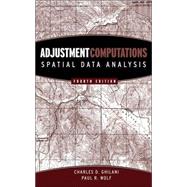
Note: Supplemental materials are not guaranteed with Rental or Used book purchases.
Purchase Benefits
What is included with this book?
Paul R. Wolf, PhD, deceased, was Emeritus Professor, Department of Civil and Environmental Engineering, University of Wisconsin. He was the author of Elements of Photogrammetry and coauthor of the bestselling Elementary Surveying, now in its eleventh edition.
| PREFACE. | |||
| ACKNOWLEDGMENTS. | |||
| 1 INTRODUCTION. | |||
|
|||
|
|||
|
|||
|
|||
|
|||
|
|||
|
|||
|
|||
|
|||
| 2 OBSERVATIONS AND THEIR ANALYSIS. | |||
|
|||
|
|||
|
|||
|
|||
|
|||
|
|||
|
|||
|
|||
|
|||
|
|||
|
|||
|
|||
| 3 RANDOM ERROR THEORY. | |||
|
|||
|
|||
|
|||
|
|||
|
|||
|
|||
|
|||
|
|||
| 4 CONFIDENCE INTERVALS. | |||
|
|||
|
|||
|
|||
|
|||
|
|||
|
|||
|
|||
|
|||
| 5 STATISTICAL TESTING. | |||
|
|||
|
|||
|
|||
|
|||
|
|||
|
|||
| 6 PROPAGATION OF RANDOM ERRORS IN INDIRECTLY MEASURED QUANTITIES. | |||
|
|||
|
|||
|
|||
|
|||
|
|||
| 7 ERROR PROPAGATION IN ANGLE AND DISTANCE OBSERVATIONS. | |||
|
|||
|
|||
|
|||
|
|||
|
|||
|
|||
|
|||
|
|||
|
|||
|
|||
|
|||
|
|||
|
|||
|
|||
| 8 ERROR PROPAGATION IN TRAVERSE SURVEYS. | |||
|
|||
|
|||
|
|||
|
|||
|
|||
|
|||
|
|||
| 9 ERROR PROPAGATION IN ELEVATION DETERMINATION. | |||
|
|||
|
|||
|
|||
|
|||
|
|||
| 10 WEIGHTS OF OBSERVATIONS. | |||
|
|||
|
|||
|
|||
|
|||
|
|||
|
|||
|
|||
|
|||
| 11 PRINCIPLES OF LEAST SQUARES. | |||
|
|||
|
|||
|
|||
|
|||
|
|||
|
|||
|
|||
|
|||
|
|||
|
|||
|
|||
|
|||
|
|||
|
|||
|
|||
|
|||
| 12 ADJUSTMENT OF LEVEL NETS. | |||
|
|||
|
|||
|
|||
|
|||
|
|||
|
|||
|
|||
| 13 PRECISION OF INDIRECTLY DETERMINED QUANTITIES. | |||
|
|||
|
|||
|
|||
|
|||
|
|||
| 14 ADJUSTMENT OF HORIZONTAL SURVEYS: TRILATERATION. | |||
|
|||
|
|||
|
|||
|
|||
|
|||
|
|||
|
|||
| 15 ADJUSTMENT OF HORIZONTAL SURVEYS: TRIANGULATION. | |||
|
|||
|
|||
|
|||
|
|||
|
|||
|
|||
|
|||
| 16 ADJUSTMENT OF HORIZONTAL SURVEYS: TRAVERSES AND NETWORKS. | |||
|
|||
|
|||
|
|||
|
|||
|
|||
|
|||
|
|||
|
|||
| 17 ADJUSTMENT OF GPS NETWORKS, | |||
|
|||
|
|||
|
|||
|
|||
|
|||
|
|||
|
|||
|
|||
|
|||
| 18 COORDINATE TRANSFORMATIONS. | |||
|
|||
|
|||
|
|||
|
|||
|
|||
|
|||
|
|||
|
|||
|
|||
| 19 ERROR ELLIPSE 369 | |||
|
|||
|
|||
|
|||
|
|||
|
|||
|
|||
|
|||
|
|||
| 20 CONSTRAINT EQUATIONS. | |||
|
|||
|
|||
|
|||
|
|||
|
|||
|
|||
|
|||
| 21 BLUNDER DETECTION IN HORIZONTAL NETWORKS. | |||
|
|||
|
|||
|
|||
|
|||
|
|||
|
|||
|
|||
|
|||
|
|||
|
|||
| 22 GENERAL LEAST SQUARES METHOD AND ITS APPLICATION TO CURVE FITTING AND COORDINATE TRANSFORMATIONS. | |||
|
|||
|
|||
|
|||
|
|||
|
|||
|
|||
| 23 THREE-DIMENSIONAL GEODETIC NETWORK ADJUSTMENT. | |||
|
|||
|
|||
|
|||
|
|||
|
|||
|
|||
|
|||
| 24 COMBINING GPS AND TERRESTRIAL OBSERVATIONS. | |||
|
|||
|
|||
|
|||
|
|||
|
|||
|
|||
| 25 ANALYSIS OF ADJUSTMENTS. | |||
|
|||
|
|||
|
|||
|
|||
|
|||
|
|||
| 26 COMPUTER OPTIMIZATION. | |||
|
|||
|
|||
|
|||
|
|||
|
|||
|
|||
|
|||
|
|||
| APPENDIX A: INTRODUCTION TO MATRICES. | |||
|
|||
|
|||
|
|||
|
|||
|
|||
|
|||
|
|||
|
|||
|
|||
|
|||
|
|||
|
|||
|
|||
| APPENDIX B: SOLUTION OF EQUATIONS BY MATRIX METHODS. | |||
|
|||
|
|||
|
|||
|
|||
|
|||
|
|||
|
|||
| APPENDIX C: NONLINEAR EQUATIONS AND TAYLOR’S THEOREM. | |||
|
|||
|
|||
|
|||
|
|||
|
|||
|
|||
|
|||
| APPENDIX D: NORMAL ERROR DISTRIBUTION CURVE AND OTHER STATISTICAL TABLES. | |||
|
|||
|
|||
|
|||
|
|||
|
|||
| APPENDIX E: CONFIDENCE INTERVALS FOR THE MEAN. | |||
| APPENDIX F: MAP PROJECTION COORDINATE SYSTEMS. | |||
|
|||
|
|||
|
|||
|
|||
| APPENDIX G: COMPANION CD. | |||
|
|||
|
|||
|
|||
|
|||
| BIBLIOGRAPHY. | |||
| INDEX. |
The New copy of this book will include any supplemental materials advertised. Please check the title of the book to determine if it should include any access cards, study guides, lab manuals, CDs, etc.
The Used, Rental and eBook copies of this book are not guaranteed to include any supplemental materials. Typically, only the book itself is included. This is true even if the title states it includes any access cards, study guides, lab manuals, CDs, etc.